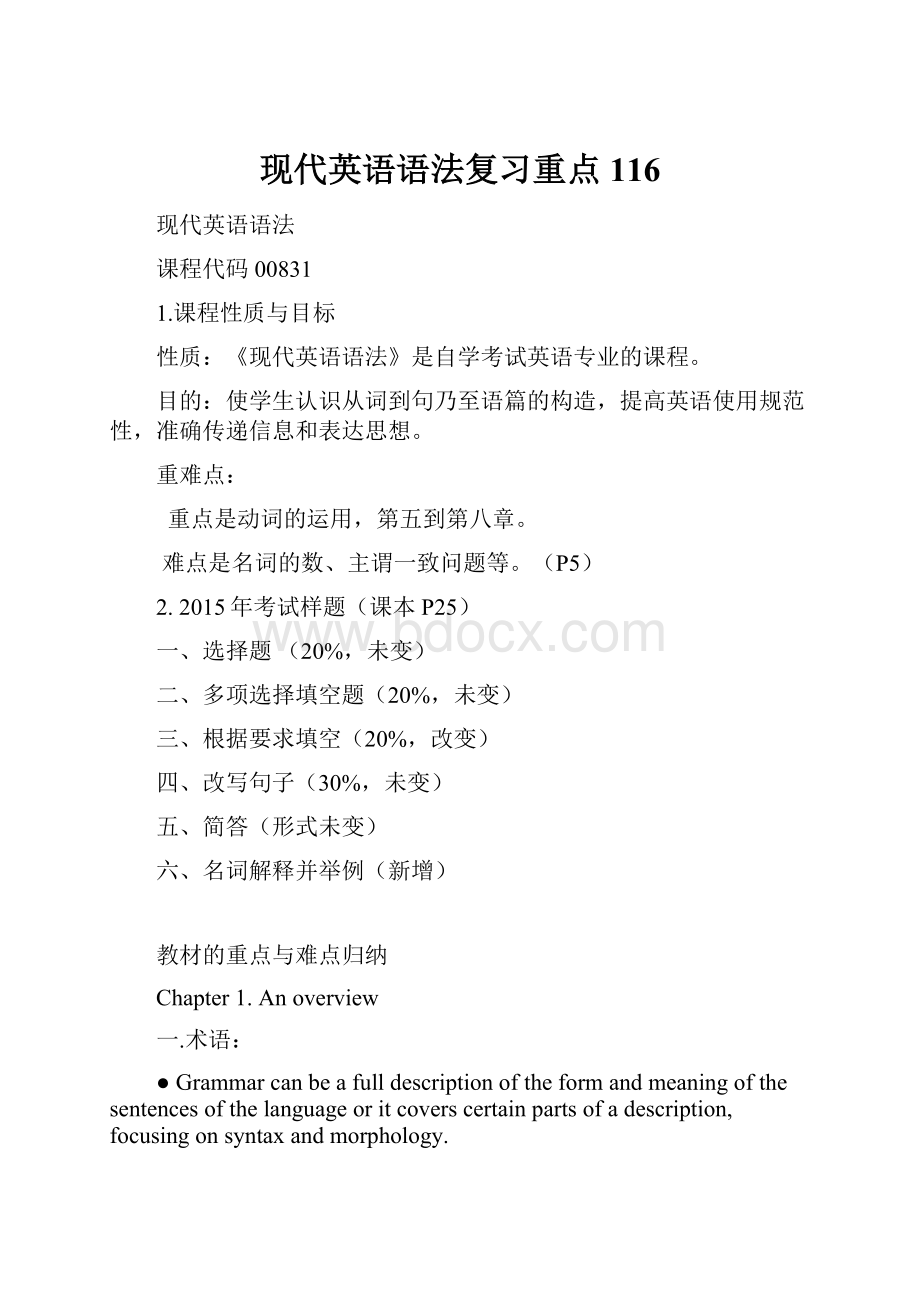 现代英语语法复习重点116Word文件下载.docx
现代英语语法复习重点116Word文件下载.docx
- 文档编号:22876556
- 上传时间:2023-02-05
- 格式:DOCX
- 页数:39
- 大小:51.63KB
现代英语语法复习重点116Word文件下载.docx
《现代英语语法复习重点116Word文件下载.docx》由会员分享,可在线阅读,更多相关《现代英语语法复习重点116Word文件下载.docx(39页珍藏版)》请在冰豆网上搜索。

alsocalledlexicalwords,focusontheformofwords.Theirmembershipisfairlyopen-ended,sowecancoinnewwordstoaddtothem.Eg:
N,V,Adj,Adv.
●closedclass(封闭词类):
alsocalledgrammaticalwords,focusingonfunctionsofwords.Theirmembershipisfixedandnowordscanbecreated.Eg:
Det,pron,prep,conj,aux.
二、语法单位的层级结构
英语句子的结构层次是:
分句(clauses)、词组(phrases)、单词(words)、词素(morpheme)
Inwritingsystems,thehierarchicalstructureis:
HigherAtextconsistsofoneormoresentences
Asentenceconsistsofoneormoreclauses
Aclauseconsistsofoneormorephrases
Aphraseconsistsofoneormorewords
Awordconsistsofoneormoremorphemes
LowerAmorpheme
三.句子分类(按构成)
Simple~(简单句):
Asentenceconsistsofonlyoneclause.
Compound~(复合句又并列句):
Inasentencecontainingmorethanoneclause,iftheclausesarerelatedtooneanotherbycoordination,itisacompoundsentence.
Complex~(复杂句又叫主从句):
Inasentencecontainingmorethanoneclause,iftheclausesarerelatedtooneanotherbysubordination,itisacomplexsentence.
四、句子类型(按功能)
Statements(陈述句),commands(命令句)
questions(疑问句),exclamations(感叹句)
Chapter2.Word-formation构词法
七种构词法:
1.Composition组合法
2.derivation派生法
3.conversion转化法
4.blending拼缀法
5.back-formation逆生法;
逆序造词
6.shortening缩略法
7.acronym['
æ
krənɪm]首字母缩写法
一、术语
●Word-formationisthecreationofanewword.构词就是新词的创造。
●Derivation=affixation:
itisacombinationofarootandoneormoreaffixes.在一个词基(通常是个单词)前面或者后面添加词缀。
如:
nation----national
●Compound:
itisacombinationoftwoormorefreemorphemes.复合词是两个或者多个自由词素组合而成。
如:
playboy=play+boy
●Conversion,isthederivationalprocesswherebyanitemisconvertedtoanewwordclasswithouttheadditionofanaffix.(不加词缀,但是词类发生转变)如answer:
v——answer:
n
●Blendingisaprocesstocreateanewwordfrompartsoftwootherwords.拼缀词是由两个词的不同部分组成的。
smoke(烟)+fog(雾)=smog(烟雾)
●Back-formation
refers
to
the
process
of
creating
a
new
wordby
removing
actual
or
supposed
affixes.将原来单词的真实或者潜在的词缀去掉,从而得到的新词。
work-er——work
●Shorteningisaprocesswherebypartofawordisclipped(剪切,截除)sothattheoriginalword,usuallypolysyllabic(多音节的),isreducedtoasmallerwordwithoutachangeinitsfunction.将原来的多音节单词的某一部分截除掉,使它成为一个较短的单词,并不改变词的功能。
ad=advertisement,phone=telephone
●Anacronymisawordcoined(=created创造)byputtingtogethertheinitiallettersofagroupofwords.把一组单词的首字母放在一起而创造新词。
VIP=veryimportantperson
本章多注意辨别7种构词法并且能够举例说明。
Chapter3.Nouns,pronounsandnumber名词,代词和数
1、术语
●Anounisawordthatnamesaperson,place,thing,eventoridea.
●Anounphrasehasakeyelementcalledtheheadword(中心词)andthismaybeprecededbyasubsidiaryelementcalledamodifier(修饰语).名词短语有个重要成分叫做中心词,前面可能有个辅助成分叫做修饰语。
eg:
anicegirl
●Apronounisapro-formthatsubstitutesforanounornounphrase.Thereplacednouniscalledtheantecedentofthepronoun.代词是用来代替名词或者名词短语的一种替代形式。
被代替的名词叫做代词的先行词。
she,he....
●Numberisafeatureofnouns,pronouns,determinersandverbsinEnglish.数是英语中的名词、代词、限定词和动词的一种特征。
●Apropernounisanameusedforaparticularperson,placeorthing,andspeltwithacapitalinitialletter.专有名词是表示特定的人、地点和事物,拼写时第一个字母大写。
●Acommonnounisanamecommontoaclassorpeople,thingsorabstractideas.普通名词表示一般类别、人群、事物或者抽象概念。
●Acountablenounisanounthathasapluralandwhichcancollocatewithnumbersandwithdeterminers.可数名词有复数,可与数字和表示数量的修饰语搭配。
●Anon-countablenounisanounwhichhasonlyoneformandcanbeusedwithoutadeterminer.不可数名词只有一个词形,不用与修饰语搭配使用。
2、名词分类
名词--|专有名词
|普通名词--|可数名词--|具体名词(concretenouns)
(commonn.)||抽象名词(abstractnouns
|物质名词--|具体名词(concretenouns)
|抽象名词(abstractnouns)
3、代词分类
区分人称代词的主格和宾格,形容词性物主代词和名词性物主代词,及反身代词。
人称代词主格(作主语):
I,you,she,he,it,we,they
人称代词宾格(作宾语):
me,you,her,him,it,us,them
形容词性物主代词:
my,your,his,her,its,our,their
名词性物主代词:
mine,yours,his,hers,its,ours,theirs.
反身代词:
myself,yourself,herself,himself,itself,ourselves,themselves...
4、名词的单复数
A:
规则的可数名词的复数变化规则:
1.一般情况加
s
:
book--
books
mouth---mouths
house---houses
girl---girls
2.以
、
sh
ch
x结尾的加
es
class---
classes
box----boxes
match----matches
3.辅音字母
+
y结尾的变
y为
i加es:
city---cities
country----countries
party----parties
factory----factories
4.以f,
fe
结尾的
变f或fe为v
+es
B.不规则变化
1.man—men,
woman—women,
tooth—teeth,
foot—feet,
2.单复数相同:
sheep,
deer,
Chinese,
Japanese
.
3.以man,
woman
修饰名词构成合成词时,两个词都变化.
man
servant—men
servants.
doctor—women
doctors.
!
本章注意名词的单复数变化情况,并且根据名词单复数选择合适的谓语动词单复数。
完成课后习题II和V.
Chapter4.Determinersandgenitives限定词和属格
Determinersrefertowordswhichareusedinthepremodificationofanounphraseandwhichtypicallyprecedeanyadjectivesthatpremodifytheheadword.限定词指的是用在名词短语前置修饰语中的词,一般在修饰中心词的形容词之前。
Groupgenitivereferstothegenitiveformedbyadding’stothelastelementofapostmodifiedorcoordinatednounphrase.
Thedoublegenitivealsocalled“postgenitive”becauseitisacombinationofthegenitiveandtheof-phrase.
双重属格又叫后置所有格,它是所有格和of短语的组合。
2、限定词:
1.常见限定词(P91第二段):
articles冠词,possessivepronouns物主代词,demonstrativepronouns指示代词,numerals数词。
2.限定词功能:
identifier识别功能quantifiers数量功能
限定词可以表示definitereference特指;
indefinitereference泛指
3.当多个限定词同时出现共同修饰中心词时排列顺序,如课本(P93表格):
前位限定词:
all,both,twice,many…
中位限定词:
冠词,指示词,物主代词,所有格…
后位限定词:
基数词,序数词,many,much,little...
3.一些限定词的用法
1.Allandboth
Both(两者之间)都;
all(三者或者三者以上)都
2.all,everyandeach
All:
侧重整体。
Every:
侧重整体中的所有个体。
Each:
侧重整体中的每一个个体。
____thegirlslikeshopping.
____girllikesshopping.
____girlhasherownwayofshopping.
3.both,eachandeither
Both两者都…;
Each每一个…;
Either…(or)两者之一
Eg:
Bothsides=each/eitherside
4.any,either,no(none)andneither
Any和no(none)三者或三者以上,either和neither两者之间。
四、属格有以下几种表示方式:
1.在词尾'
s.Eg:
Lucy’sbook
2.of短语的形式。
thecoverofthebook书的封面
3.双重属格的形式。
aphotoofLucy’s露西照片中的一张
区分:
aphotoofmybrother’s我兄弟的一张照片(属于他,不一定是他)
aphotoofmybrother一张我兄弟照片(上面就是我兄弟)
4.Groupgenitive集体属格
若并列的两部分共同拥有某物,则在后一个词后加’s.
LucyandLily’sroom共有的房间
若并列的两部分各自拥有某物,则每个词后加’s.
Lucy’sandLily’sroom各自的房间
5.Localgenitive地点属格
thebakers’面包店,atHarry’s在哈利家
Chapter5.Tenseandaspect时态和体
一、时态和体
英语动词系统包括:
两种时态tense(现在和过去),两种体aspect(进行体和完成体),三种语气mood(陈述,虚拟和祈使),两种语态(主动和被动)。
Twoaspectforms:
两种体:
theprogressiveaspect进行体
theperfectiveaspect完成体
体和时态自由搭配,形成以下各式:
●一般现在时:
v原形或者三单形式
●一般过去时:
v过去式
●一般将来时:
will/begoingto+v原形
●现在进行体:
be+v-ing
●过去进行体:
was/were+v-ing
●现在完成体:
has/have+v.pp(动词过去分词)
●过去完成体:
had+v.pp
●现在完成进行体:
has/havebeendoing
●过去完成进行体:
hadbeendoing
具体的各种时态用法,可参照已经发给大家的时态表格。
二、术语:
Tense:
Itreferstothetemporallocationsoftheevet--eitherthepresentorthepast.
时态表明时间发生的时间点,现在或是过去。
Aspect:
Itreferstothestateofanaction--whetheritiscompletedornotcompleted.
体表明一个动作的状态,完成的还是未完成的。
Chapter6Voiceandmood语态和语气
Voice:
Apropertyofverbsorasetofverbinflectionsindicatingtherelationbetweenthesubjectandtheactionexpressedbytheverb.
(态)是表示主语和动词之间的主动或被动关系的动词形式。
英语动词有两种态:
主动态和被动态。
Mood:
Asetofverbformsorinflectionsusedtoindicatethespeaker'
sattitudetowardthefactualityorlikelihoodoftheactionorconditionexpressed.语气用来强调说话人对表达的行为或条件的真实性或可能性所持有态度的一系列动词形态或变化形式。
英语语气有三种:
陈述语气(indicative),祈使语气(imperative),虚拟语气(subjunctive)。
二、被动语态的构成:
be+v.pp(口诀:
被动语态be字变,过去分词跟后面。
)
1.一般现在时:
am/is/are+v.pp(过去分词)
2.一般过去时:
was/were+v.pp
3.一般将来时:
willbe(原形)+v.pp
4.现在进行时:
am/is/are+being+v.pp
5.过去进行时:
was/were+being+v.pp
6.现在完成时:
has/havebeen+v.pp
7.过去完成时:
hadbeen+v.pp
8.情态动词被动语态:
should/could/wouldbe+v.pp
3、被动语态用法
一般在动作的执行者(施事)未知或没必要提及时,使用被动语态,突出动作的承受者(受事)。
若要提及施事,则使用by短语。
注意:
1.系动词如taste,sound,smell,look,see等词不可用于被动语态,直接接形容词作表语。
Theseflowerssmellgreat.这些花闻起来棒极了!
2.在need,want,require,
bear等词的后面,动名词用主动形式表示被动意义,其含义相当于动词不定式的被动形式。
The
house
needs
repairing.=Thehouseneedsto
be
repaired.
这房子需要修理。
3.主动语态变为被动语态时,可按三个步骤:
a.把主动语态的宾语变为被动语态的主语。
b.把谓语变成被动结构(be+done)
,并根据被动语态句子里的主语的人称和数以及原来主动语态句子中动词的时态来决定be的形式。
c.把主动语态中的主语放在介词by之后作宾语,将主格改为宾格。
在无须说明动作的执行者或只强调动作的承受者时,by短语可以省略。
4、虚拟语气
表主观愿望、假设、建议,通常是表示未实现的行为或者与事实相反的行为。
1.实现手段:
modalauxiliaries情态助动词
pasttenseforms过去时形式
pastperfectforms过去完成时形式
2.两大类型:
be-subjunctiveandwere-subjunctive
be型虚拟语气和were型虚拟语气
3.虚拟语气的形式
A.动词原形,用于一切人称和数.
B.动词的过去式,用于一切人称和数,be用were.
C.过去完成时,即had+done(过去分词)。
D.当表示“意愿,意志”时,它引导的that从句可以使用should+动词原形构成虚拟语气。
此时should可以省略,这类词有:
advise,suggest,require,command...以及它们对应的adj或者n...
eg:
Hesuggestedthatwe(should)stayathome.
E.情态动词+havedone.与事实相反
F.“Itis(high/about)time...”后跟虚拟语气,从句常用过去式,也用“should+动词原形”,意为“是...的时候了”。
G.If引导的条件
- 配套讲稿:
如PPT文件的首页显示word图标,表示该PPT已包含配套word讲稿。双击word图标可打开word文档。
- 特殊限制:
部分文档作品中含有的国旗、国徽等图片,仅作为作品整体效果示例展示,禁止商用。设计者仅对作品中独创性部分享有著作权。
- 关 键 词:
- 现代 英语语法 复习 重点 116
 冰豆网所有资源均是用户自行上传分享,仅供网友学习交流,未经上传用户书面授权,请勿作他用。
冰豆网所有资源均是用户自行上传分享,仅供网友学习交流,未经上传用户书面授权,请勿作他用。


 《城市规划基本知识》深刻复习要点.docx
《城市规划基本知识》深刻复习要点.docx
